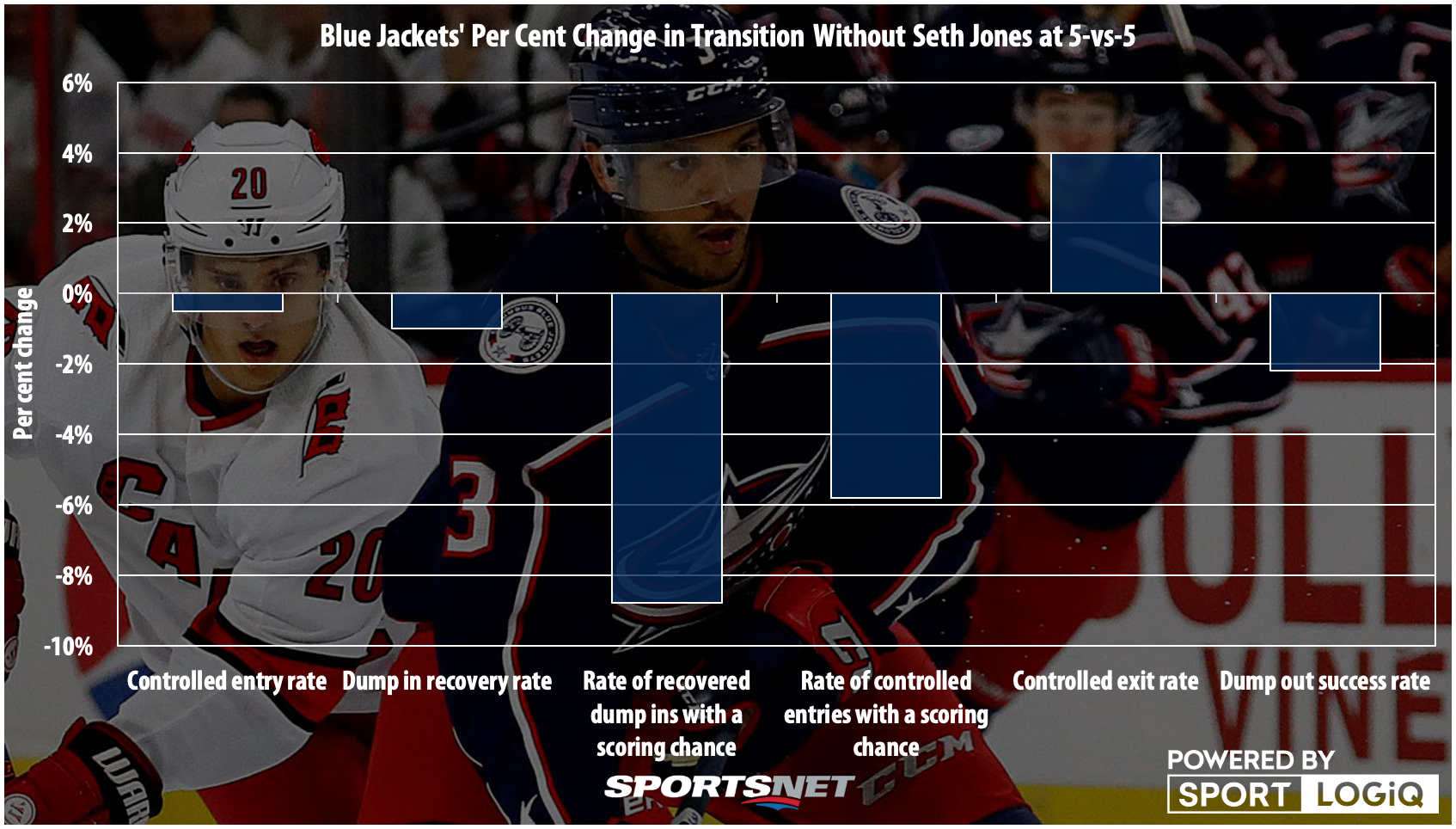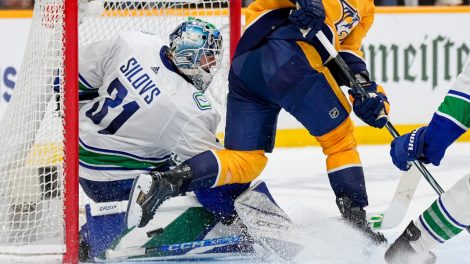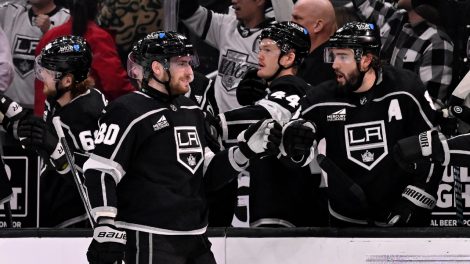In a playoffs or play-in round filled with questions and uncertainty after the NHL has been on a break for over four months, one of the biggest queries heading into games is how big of an x-factor Seth Jones will be for the Columbus Blue Jackets.
The Jackets continually shocked pundits this season by sticking in the playoff picture despite losing Artemi Panarin and Sergei Bobrovsky in the off-season, applying a full-unit approach to a low-risk forechecking game that gave them more success than anticipated. They further surprised when they were hit by injuries arguably worse than any other team this season, but maintained a high level of play, thanks in part to brilliance in goal from Elvis Merzlikins down the stretch.
Seth Jones missed a little more than the last month of the regular season, last playing against the Avalanche on Feb. 8. As a player who logs gigantic minutes and has been boosted for Norris Trophy consideration by mainstream media in recent years, you would expect that would be a massive return, but lately there have been some questions about him.
[snippet id=4167285]
JFreshHockey broke down how Jones’ macro-level statistics like on-ice shot attempt differentials and expected goals differentials alongside robust regression models like Evolving Hockey’s WAR (Wins Above Replacement) don’t show the elite player that many believe Jones to be, despite his decent defensive impact.
Meanwhile Jack Han, formerly an assistant coach with the Toronto Marlies, broke down a weakness in Jones’ defensive game that holds him back — his skating in a defensive posture while defending man-to-man rushes.
Neither of these articles are attempting to say that Jones is a bad player, but perhaps there’s less of an impact to be seen from Jones returning than many would expect. I reached out to Alison Lukan of The Athletic for a bit more context, since she understands all the fine details of the way the Blue Jackets play, and Jones’ role in that system.
Lukan had mentioned in a panel discussion I participated in that Jones’ role changed this season, and expanded to say that Jones had to change his game a little bit, sacrificing offence in order to cover for Zach Werenski and allow him to rove a bit more, while shouldering the defensive load.
She also suggested that the Blue Jackets’ transition game changed without Jones in the lineup, so those are two areas we can look at to evaluate how Jones could impact the upcoming series against the Toronto Maple Leafs.
From an overall skills perspective, it’s clear that the adjustments to Jones’ game did hurt his effectiveness a little bit. According to Sportlogiq’s data, Jones has been a top-10 per cent defenceman overall in the NHL at even strength by individual contributions in each of the 2016-17, 2017-18, and 2018-19 seasons, but dropped to around the top-20 per cent this season, his lowest rating since these metrics began to be recorded in a league-wide database in 2015-16.
From an individual perspective Jones remained an elite transition player though, so let’s take Lukan’s suggestion and look at the Blue Jackets’ transition game with and without Jones this season.

On the surface Jones’ impact on transition seemed relatively small. The Blue Jackets’ controlled entry rate dropped by less than one per cent, which was surprising since Jones is in the top two per cent of all defencemen in controlled entries, with 1.46 ever 20 minutes of play at even strength, but as you dig in a bit more the change gets more severe.
On top of being a strong controlled entry player, Jones knows how and where to dump the puck in effectively in order to engineer recoveries. Without his presence on the ice, the Blue Jackets were dumping the puck in a little bit more often, but also recovering the puck less often on those dump-ins.
The cascading impact of his loss got more severe as the granular data got finer as well, as the Blue Jackets’ ability to create scoring chances both off dump-ins and controlled entries dropped considerably. A near six percentage point drop in the number of controlled entries that resulted in a scoring chance, and nearly a nine percentage point drop for scoring chances off recovered dump-ins.
With Jones in the lineup, the Blue Jackets were creating scoring chances on 22.3 per cent of their recovered dump-ins, and 24.3 per cent of their controlled entries. Without Jones, those numbers dropped to 13.5 per cent and 18.5 per cent, respectively. Those are massive drop-offs.
When exiting the defensive zone, Jones likes to dump the puck out more than most players, so his team actually exited the zone with control more often while he was injured, but they clearly weren’t able to turn those extra possessions into more offence without him.
[snippet id=3816507]
On the defensive side of the puck, Jones was in the top-five per cent of all defencemen in blocked passes in the defensive zone, though he and Werenski were the pairing that allowed the most inner-slot shots or high-danger chances against per minute played. That isn’t uncommon for a team’s top pairing though, since they often get matched with the more offensively talented opponents.
To get a better idea of Jones’ defensive impact, let’s look at Werenski’s on-ice results with Jones in the lineup versus while Jones is on the injured reserve. Of note, when looking at on-ice metrics against a player, a positive per cent of change is a bad thing, you don’t want those increasing.

Without Jones in the lineup, the Blue Jackets began to play more conservatively in order to avoid putting more pressure on their goaltenders, and perhaps Jones’ man-on-man weaknesses pointed out by Jack Han’s piece factored into Werenski managing to lower the number of on-ice inner-slot shots against him by eight per cent, but it came at the cost of a nearly a 25 per cent drop in offence.
Things got worse when you look at passing, where opponents were able to generate eight per cent more slot passes against Werenski without Jones’ proficient cutting off of passing lanes, while offensively the Blue Jackets were creating 11.5 per cent fewer slot passes of their own with their top offensive defenceman on the ice.
In shots on goal the results were far more muted, but the poor trend held, with fewer shots for and more shots against, while shot attempt volume just dropped overall.
Jones has his weaknesses, like any player, but his impact on the Blue Jackets’ system is relatively large at both ends of the ice. The question though, is how much does his specific skill set factor in against the Maple Leafs?
[snippet ID=3322139]
The Blue Jackets’ ability to forecheck and create scoring chances off of dump-ins while Jones is in the lineup should be particularly worrisome for the Leafs, since they were dead last in the NHL this season with 23.4 per cent of their opponents’ recovered dump-ins being turned into scoring chances.
Similarly, the Maple Leafs were dead last in the percentage of controlled entries against that turned into scoring chances at 27.6 per cent.
The Leafs were pretty excellent at sending teams back at the blue line this season. Overall, between recovered dump-ins and controlled entries, they allowed the fewest successful zone entries in the NHL per 60 minutes at 5-vs-5, with just 50 — about five fewer than the league average and 10 fewer than the league-worst New Jersey Devils. That’s a good sign, but once opponents were able to gain the zone either way, the Leafs collapsed worse than anyone else.
If the Blue Jackets are able to consistently penetrate the Leafs’ zone with dump-ins or controlled entries, they can make this matchup a lot closer than some may think, and Jones will be a huge part of that strategy.
[relatedlinks]








